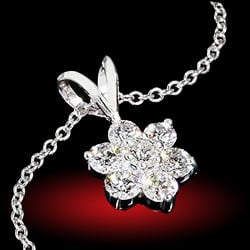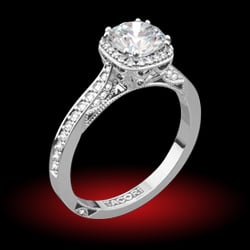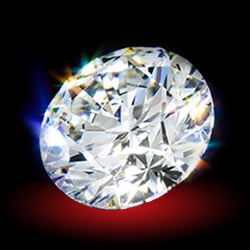- Joined
- May 25, 2005
- Messages
- 538
Buying Pairs on the Internet
If you adore individual jewelry you may soon be searching a matched pair for earrings or side stones for a ring or necklace. The internet is often the only venue to visit.
Here is some advice on how to judge pairs on the web. These are valid for all varieties, not only sapphires. Images of pairs are tricky even by gemstone standards. It is best to concentrate on facts (clarity, tone, dimensions etc.) and use the photos as additional information and overview.
The collector knows there are no two identical gemstones. Unless you settle for a calibrated and artificially colored stone cut by a machine you will have to accept some differences, especially when you use the lens. However, two gemstones need to have a similar appearance and character to be in harmony as a pair.
A practical test for two similar gems is simply to mix them up. If you need the carat weight to sort them back to their certificates they have passed the test.
In a more thorough approach let us follow the 4C to evaluate a pair:
Carat (size): Many people get overly focused on searching identical carat weight in pairs. This is not necessary and indeed very rare to find. More relevant is the so called "face", the upside dimension of a gem. Two gems might have the same carat weight and yet very different faces and vice versa.
As a rule of thumb you should be searching for gems in the same weight class, say 2-3 carat and then, more importantly, look at the dimensions of the face. Consider width and length. They are most important since they determine the visible face. A pair with too much deviation in the visible part is no good for jewelry.
How much deviation is too much? This is better looked at in relative, rather than in absolute terms. One millimeter difference on a 20mm pear shape might be acceptable but a catastrophe on a 4mm round gem. Barring exceptions we allow pairs to have max. 5% deviation from each other.
The third dimension, depth, is less relevant for your choice assuming that the face is similar and that there are no bad windows. Depth however is the main parameter for weight. Hence, you may find gemstone pairs with equal face dimensions but very different carat weight. Yet, they can be perfect twins for jewelry if the cut is good enough to cover up missing depth, which leads us to the next point:
Cut: Choosing two different cuts or even shapes, say a trillion and a square in a pair is quite exotic; and it is done rarely (but can be charming).
Generally, however, people want near identical cuts. Ideally a pair has been cut to match. It was thus faceted by the same cutter from the same rough material. With "same mine run & same cutter" one has a good chance of getting two gems with a similar character to begin with.
The more important luster is for a gemstone, the more emphasis will rest on identical cuts. A pair of white diamonds for example needs to be machine cut to be 100% equal (which they mostly are in calibrated sizes). In a less lustrous gem, say a midnight blue sapphire or a brown tourmaline, the details of each facet will not be so influential.
As mentioned before, differences in depth can be covered by a clever cutter but this has limits. Too little depth results in windows and there is no way out. If both gems show similar windows that might be OK, but it is very disharmonic to have one fish-eye and one full body sparkler displayed together.
Color: As always in this trade color beats them all. Ruby, tsavorite or sapphires are primarily bought for their magnificent colors and only secondarily for their luster. Some gems like Mali garnet, titanite or demantoid come with fire and color. As pairs they shall be judged by cut and color in equal parts too.
However, most gems are color-first animals.
Tone: Differences in tone are easier to stomach than differences in color composition (mix of 1st, 2nd and 3rd color). This is true especially in darker varieties. (Remember: Tone is the amount of black/white not the saturation). A deep blue sapphire of medium dark 75 will easily fit with a medium dark 80. But be careful with e.g. light yellow or green. There, even small differences in tone will be very visible.
Remark: We would rather suggest using pairs of completely different colors for jewelry than allow different hues in one color. Using two unconnected colors however is quite exotic and we do it only on request. (How about a neon red spinel set with two chrome green tourmalines for example?)
Hue: Where color is king - in pairs it is double. A pair with different color composition will hardly make a nice pair. Add only a bit of purple to a ruby or a tint of violet to a blue sapphire and you will need many meters (not only a face) to separate them from a red-red ruby or sky blue sapphire. A greenish blue and a bluish green sapphire, or a rose red and an orange red ruby, can not be called a pair at all. As soon as the color is visibly different there is no pair.
Remark: Hence, matching pairs are even rarer in natural gems because they lack the uniformity of treatment. Heat or diffusion brings out similar colors in similar rough. The result is a more consistent color mix. Matched unheated ruby or sapphires are therefore a difficult hunt. In fact, this is one reason for the spread of treated gems: Making a necklace with 50 matching sapphires is only possible on a high budget or with high heat. Similarly the industrial production of 5,000 rings with a similar colored blue gem demands controlled artificial coloring.
Clarity: A matching pair should be on the same clarity level. One may accept a "free of inclusions" next to a "very slightly included", meaning both are clean to the eye, but anything that is visible in jewelry should at least be visible in both gems. If a pair comes from the same mine-run, one can actually find beauty in combining identical types of visible inclusions: individual, charming and easy on the budget (think rutilated topaz in a pair).
To summarize:
- Width and length determine the visual similarity of a pair not the weight
- Better two windows than one
- The more important luster is, the more important are identical cuts
- Same-mine-same-cutter pairs are best to start with
- Differences in tone are sometimes tolerable but differences in saturation are no-no
- If inclusions are tolerated they must be visible in both stones







300x240.png)